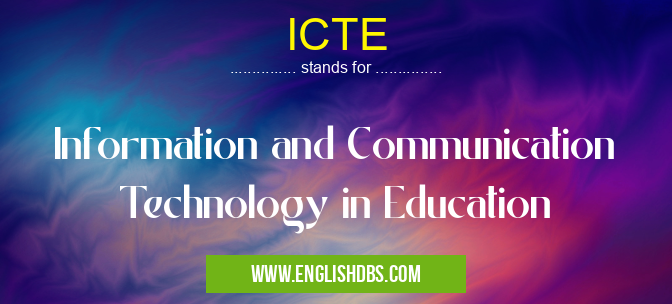What does ICTE mean in TECHNOLOGY
ICTE stands for Information and Communication Technology in Education, which encompasses the integration of technology into educational settings to enhance teaching and learning processes. ICTE involves utilizing various technologies, such as computers, the internet, multimedia, and software, to support educational objectives.

ICTE meaning in Technology in Computing
ICTE mostly used in an acronym Technology in Category Computing that means Information and Communication Technology in Education
Shorthand: ICTE,
Full Form: Information and Communication Technology in Education
For more information of "Information and Communication Technology in Education", see the section below.
» Computing » Technology
Definition
In the context of computing, ICTE refers to the application of information and communication technologies to improve educational practices. It involves the effective use of technology to:
- Enhance student learning: Create interactive and engaging learning experiences that cater to diverse learning styles.
- Facilitate teaching: Provide teachers with tools and resources to enhance lesson delivery and manage classroom activities efficiently.
- Improve access to education: Extend learning opportunities beyond traditional classroom settings, making education more accessible and flexible.
- Foster collaboration and communication: Promote communication and collaboration among students, teachers, and parents.
- Promote lifelong learning: Support continuous learning and professional development opportunities for both educators and learners.
Benefits of ICTE
ICTE offers numerous benefits in the educational realm, including:
- Increased engagement and motivation: Technology can make learning more interactive and engaging, fostering student interest and motivation.
- Personalized learning: ICTE enables tailored learning experiences that cater to individual student needs and learning styles.
- Improved collaboration and communication: Online platforms and tools facilitate collaboration among students, teachers, and parents, enhancing communication and feedback.
- Enhanced access to resources: Technology provides students and educators with access to a vast array of educational resources and materials beyond traditional textbooks.
- Preparation for the digital workforce: ICTE prepares students for the digital workforce by fostering technological literacy and problem-solving skills.
Challenges of ICTE
While ICTE offers significant benefits, it also presents certain challenges:
- Digital divide: Unequal access to technology and digital literacy can create disparities in educational opportunities.
- Teacher training: Educators require training and support to effectively integrate technology into their teaching practices.
- Cost and infrastructure: Implementing and maintaining ICTE infrastructure can be costly, particularly in resource-constrained settings.
- Security and privacy concerns: It is essential to address security and privacy concerns related to the storage and use of educational data.
- Ethical use of technology: Ethical considerations should guide the use of technology in education, ensuring it aligns with educational values and promotes equity.
Essential Questions and Answers on Information and Communication Technology in Education in "COMPUTING»TECHNOLOGY"
What is the role of ICTE in education?
ICTE plays a crucial role in education by enhancing teaching and learning processes, improving student engagement, and facilitating access to educational resources. It involves the integration of technology, such as computers, software, and the internet, into educational settings to enhance learning outcomes.
What are the benefits of using ICTE in education?
ICTE offers numerous benefits in education, including:
- Improved student engagement and motivation
- Enhanced learning outcomes and knowledge retention
- Increased collaboration and communication among students, teachers, and parents
- Personalized learning experiences tailored to individual needs
- Wider access to educational resources and information.
How can ICTE be effectively integrated into the classroom?
To effectively integrate ICTE into the classroom, consider the following strategies:
- Identify specific learning objectives that ICTE can support
- Choose appropriate technologies that align with the curriculum
- Provide teachers with professional development on ICTE integration
- Foster a collaborative environment where students can engage with technology
- Set clear expectations for technology use and monitor student progress.
What are some examples of ICTE tools and resources?
ICTE encompasses a wide range of tools and resources, such as:
- Learning management systems (LMS)
- Virtual learning environments (VLE)
- Educational software and apps
- Interactive whiteboards and projectors
- Video conferencing tools
- Online libraries and databases.
How can ICTE address educational equity and access?
ICTE can contribute to educational equity and access by:
- Providing access to educational resources for students in remote or underserved areas
- Offering online learning opportunities for students who may not be able to attend traditional schools
- Facilitating communication and collaboration among students and teachers from diverse backgrounds
- Personalizing learning experiences to meet the individual needs of students.
Final Words: ICTE plays a vital role in modern education, enhancing learning experiences, improving teaching practices, and fostering collaboration. While challenges exist, it is crucial to address them to leverage ICTE's full potential in transforming education. By embracing technology and addressing its limitations, educators and policymakers can create more equitable and effective learning environments for all.
